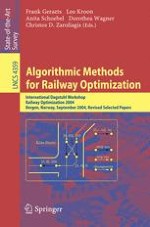2007 | Buch
Algorithmic Methods for Railway Optimization
International Dagstuhl Workshop, Dagstuhl Castle, Germany, June 20-25, 2004, 4th International Workshop, ATMOS 2004, Bergen, Norway, September 16-17, 2004, Revised Selected Papers
herausgegeben von: Frank Geraets, Leo Kroon, Anita Schoebel, Dorothea Wagner, Christos D. Zaroliagis
Verlag: Springer Berlin Heidelberg
Buchreihe : Lecture Notes in Computer Science
